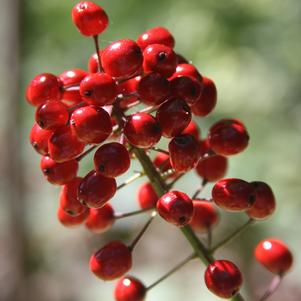General Description
Bloom Description: No flowers: the fronds are slow to appear in spring, usually arising in late May. The fronds are deciduous, and when growing in more open areas, turn yellow in fall.
Growth Habit & Shape: This is a long-creeping fern that is slow to become established and tends to grow in random patches.The leaf is broader than it is long, and the leaflets are coarsely lobed. It is not a delicate-looking plant, but it is difficult to establish in the garden due to its slow habit, intolerant of competition for ground area. Its fronds, although coarse, are wavy and give the plant an interesting appearence.
Soil Preferences: This plant prefers the rich, humusy loam found in forest understories. The soil moisture can range from fairly dry to evenly moist. Plenty of leaf mulch or humus can help this plant take hold in otherwise sandy sites.
Root Description: Once established, this fern spreads freely via long-creeping rhizome. "Long-creeping" refers to the fact that fronds (leaves) arise at least one inch apart along the rhizome.
Garden Uses: The broad beech fern has a coarser texture than its cousin, the long beech fern. Its foliage and form can be distinctive among other plants and ferns; it works as a great groundcover under large trees, where it is tolerant of the dry surface soils. The fronds are broader than long with wavy edges, appropriate for adding interest and diversity in plant material.
Best Management & Maintenance: Once planted, to not disturb the plant until it can become established. Once the plant takes hold, it is possible to divide plants out of the edge of the clump and transplant to other locations in early spring prior to new growth. Plenty of leaf mulch or humus can help this plant take hold in otherwise sandy sites.
Common Problems: slugs, occasionally (see Mickel, 1994)
Benefits
Ornamental Value: This plant has a beautiful texture and an even green color through the summer. It tends to run far and wide, making random patches. It is slow to become established, so it is still a good choice for the garden. Ferns provide a place for the eye to rest in a colorful garden spaces.
Wildlife Benefits: cover for amphibians, insects, rodents.
Other Practical/Environmental Benefits: soil stabilization
Ecology
Habitat:
In moist woods, usually in full shade, often in moderately acid soils.
Ecosystems:
This species is listed in the following United States National Vegetation Classification macrogroups:
-M008 Southern Mesic Mixed Broadleaf Forest Macrogroup
-M016 Southern & South-Central Oak - Pine Forest & Woodland Macrogroup
-M883 Appalachian-Interior-Northeastern Mesic Forest Macrogroup
-M882 Central Midwest Mesic Forest Macrogroup
-M014 Laurentian-Acadian Mesic Hardwood - Conifer Forest Macrogroup
-M503 Central Hardwood Swamp Forest Macrogroup
-M033 Southern Coastal Plain Basin Swamp & Flatwoods Macrogroup
Response to Disturbance: This fern, like many others, needs a stable system in order to grow and form large colonies. Soil disturbance is a strong disruptive factor in the survival and sustainment of colonies. Likewise, following any drastic environmental change (light, heat, humidity), plants may require a full growing season for new fronds to become modified to meet the demands of the newly-imposed conditions (see article by C.N. Page, listed in references).
Native State Distributions:
Canada: Ont., Que.;
USA: AL, AR, CT, DE, D.C., FL, GA, IL, IN, IA, KS, KY, LA, ME, MD, MA, MI, MN, MS, MO, NH, NJ, NY, NC, OH, OK, PA, RI, SC, TN, TX, VT, VA, WV, WI.
Wetland indicator status: FACU
References
- Brooklyn Botanical Garden: How to Grow Ferns
- Native Plants for Georgia Part II: Ferns. © The University of Georgia, 2017
- GoBotany
- USDA Plants profile
- USNVC [United States National Vegetation Classification]. 2019. United States National Vegetation Classification Database, V2.03. Federal Geographic Data Committee, Vegetation Subcommittee, Washington DC. [usnvc.org]
- NatureServe. 2019. NatureServe Explorer: An online encyclopedia of life [web application]. Version 7.1. NatureServe, Arlington, Virginia.
- Flora of North America Editorial Committee, eds. 1993+. Flora of North America North of Mexico. 19+ vols. New York and Oxford.
- Page, C. (2002). Ecological strategies in fern evolution: A neopteridological overview. Review of Palaeobotany and Palynology, 119 (1-2), 1-33.
- Leslie Duthie, Personal Communication
Return to Top

